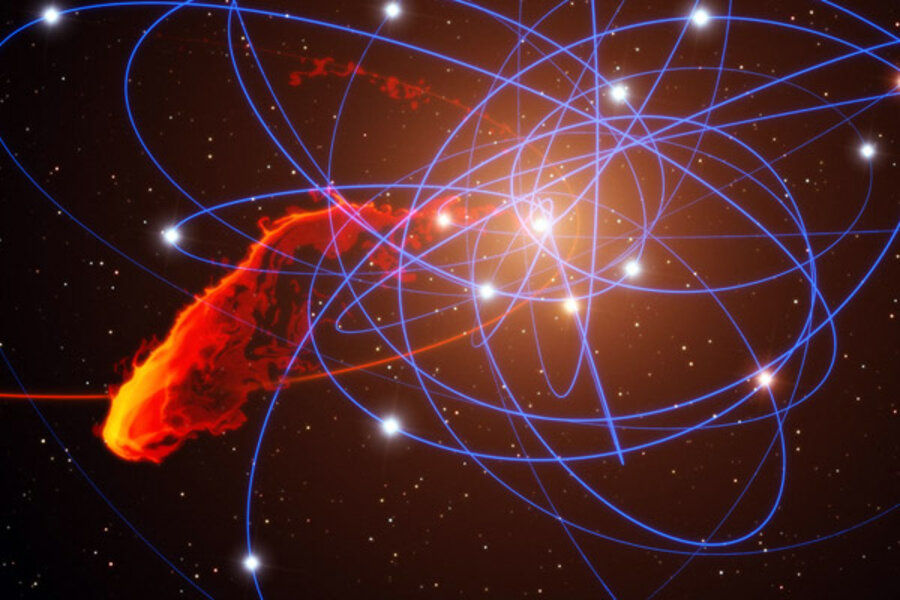Cosmic cuisine: Giant gas blob on menu for Milky Way's black hole
Loading...
For the first time, astronomers are poised to get a close look at a supermassive black hole making a meal of in-falling gas.
The black hole in question lurks in the center of the Milky Way. A vast blob of gas is orbiting the black hole, known astronomically as Sagittarius A*. And it appears to be a swan-song orbit.
At its closest approach in 2013, the gradually stretching blob will have been shredded into fragments by the black hole's gravity. The fragments are expected to swing to within 1.5 light-days of the black hole's event horizon – the point of no return for in-falling matter.
That's about 260 times the distance between Earth and the sun. The team discovering the blob calculates that some of the gas fragments will be flung into new orbits around Sagittarius A*. But the team says some of that gas may be drawn in ever-tightening circles around the black hole until it crosses the event horizon and vanishes in a burst of radiation.
"What a unique opportunity!" says an enthused Stefan Gillessen, an astrophysicist at the Max Planck Institute for Astrophysics in Garching, Germany. Dr. Gillessen led the team reporting the results in Thursday's issue of the journal Nature.
Researchers observing other galaxies millions of light-years away claim to have seen stars being disrupted by black holes, Gillessen writes in an email exchange. But the level of detail in the data hasn't been high enough to be thoroughly convincing.
"Here, we can predict that an accretion event will happen, [and] at a very close distance of 25,000 light years," he says. "The mass being fed towards the black hole is small, but we can watch it in exquisite detail."
In some ways this sounds a bit like hungry waifs staring through a restaurant window as a diner is about to take in a fork tipped with filet mignon.
But Gillessen and others say the observations will help draw a more complete picture of how black holes operate.
Such an event would help show how galactic black holes gain mass over time. And the fragments' interactions with gas already in the region could serve as a probe of environmental conditions in the black hole's immediate backyard.
Black holes are cosmic objects with so much mass squeezed into such a small volume that the strength of their gravity prevents even light, traveling at 186,000 miles a second, from escaping.
Stars far more massive than the sun typically end their lives as so-called stellar-mass black holes. These tend have the mass of about 10 suns with an event horizon only about 18 miles across.
But black holes also come supersized – behemoths stuffed with the mass of millions or billions of suns and whose event horizons can reach out to several times the distance between the sun and Pluto. These supermassive black holes are said to reside at the center of nearly all galaxies and play important roles in their evolution.
The supermassive black hole in the Milky Way's center is estimated to contain the mass of 4 million suns.
The team discovered the gas blob earlier this year as part of a larger effort to observe the region around Sagittaruis A* over long periods of time. The area remains puzzling, with so many young stars and a supermassive black hole that seems to have put itself on a diet.
Sagittarius A* appears in the constellation Sagittarius, which lies in the direction of the Milky Way's core as viewed from Earth. In 1951, radio astronomers reported having picked up radio emissions in that region, earning the source the A. Astronomers have since discovered stars orbiting a tight portion of the region with speeds greater that any found elsewhere in the galaxy. This led to the conclusion that the galaxy harbors a supermassive black hole at its center. The object was designated Sagittaruis A*.
The blob is about the size of the solar system but tips the scales at only about three times the mass of Earth. It orbits the black hole once every 137 years, give or take 11.
When the researchers examined radiation from the blob, its spectrum was extended in a way that indicated the blob was being stretched – the so-called spaghetti effect that theories envision for the impact of a black hole's gravity on matter as it approaches.
Looking back through archived images of the same region of space, the team was able to calculate the blob's orbit and track changes in its velocity with time.
In 2004 the blob was hurtling through space at about 2.7 million miles an hour, for instance. This year's observation clocked the blob at 5.2 million miles an hour.
The team notes that over the course of the 19 years during which the broader Sagittarius A* observing effort has been underway, two stars orbiting the black hole have make closer approaches than will the blob, or what's left of it. But because a star's gravity is so much greater than that of the blob, each of the two stars was able to hold itself together and keep on orbiting, Gillessen says.
When matter begins its final descent into a black hole, gravity compresses it, it heats, and emits radiation. If the team's orbital calculations are correct, the researchers say they anticipates a flare of radiation from the region of Sagittarius A* in 2013, when the fragments reach their point of closest approach.
If some of the gas gets drawn close enough to the event horizon to make the final plunge, the researchers anticipate observing a giant radiation flare from Sagittarius A* a few years later.





